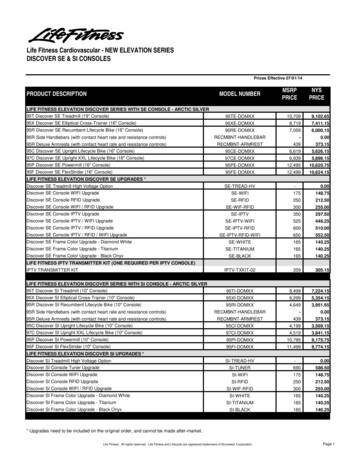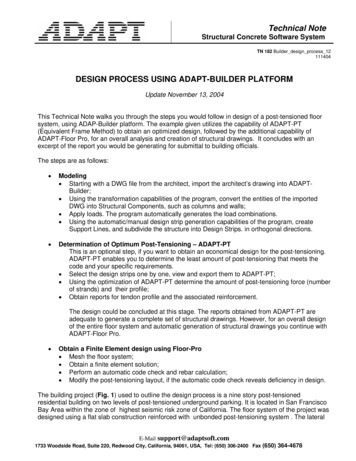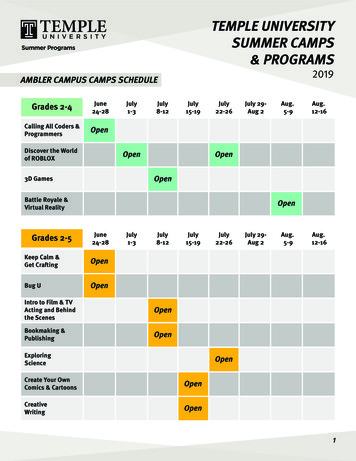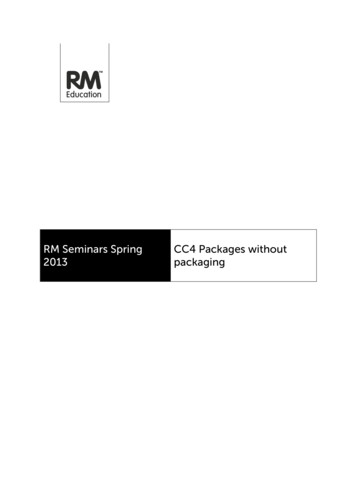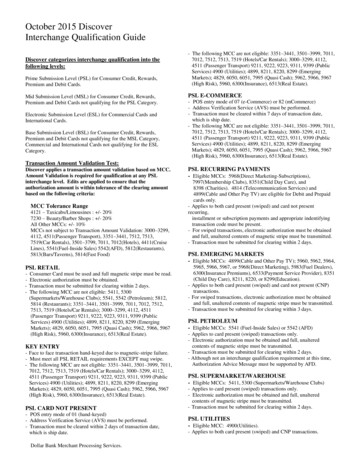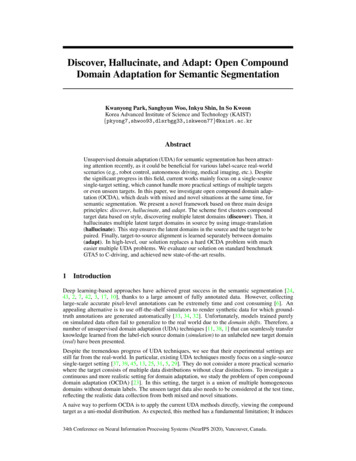
Transcription
Discover, Hallucinate, and Adapt: Open CompoundDomain Adaptation for Semantic SegmentationKwanyong Park, Sanghyun Woo, Inkyu Shin, In So KweonKorea Advanced Institute of Science and Technology .ac.krAbstractUnsupervised domain adaptation (UDA) for semantic segmentation has been attracting attention recently, as it could be beneficial for various label-scarce real-worldscenarios (e.g., robot control, autonomous driving, medical imaging, etc.). Despitethe significant progress in this field, current works mainly focus on a single-sourcesingle-target setting, which cannot handle more practical settings of multiple targetsor even unseen targets. In this paper, we investigate open compound domain adaptation (OCDA), which deals with mixed and novel situations at the same time, forsemantic segmentation. We present a novel framework based on three main designprinciples: discover, hallucinate, and adapt. The scheme first clusters compoundtarget data based on style, discovering multiple latent domains (discover). Then, ithallucinates multiple latent target domains in source by using image-translation(hallucinate). This step ensures the latent domains in the source and the target to bepaired. Finally, target-to-source alignment is learned separately between domains(adapt). In high-level, our solution replaces a hard OCDA problem with mucheasier multiple UDA problems. We evaluate our solution on standard benchmarkGTA5 to C-driving, and achieved new state-of-the-art results.1IntroductionDeep learning-based approaches have achieved great success in the semantic segmentation [24,43, 2, 7, 42, 3, 17, 10], thanks to a large amount of fully annotated data. However, collectinglarge-scale accurate pixel-level annotations can be extremely time and cost consuming [6]. Anappealing alternative is to use off-the-shelf simulators to render synthetic data for which groundtruth annotations are generated automatically [33, 34, 32]. Unfortunately, models trained purelyon simulated data often fail to generalize to the real world due to the domain shifts. Therefore, anumber of unsupervised domain adaptation (UDA) techniques [11, 38, 1] that can seamlessly transferknowledge learned from the label-rich source domain (simulation) to an unlabeled new target domain(real) have been presented.Despite the tremendous progress of UDA techniques, we see that their experimental settings arestill far from the real-world. In particular, existing UDA techniques mostly focus on a single-sourcesingle-target setting [37, 39, 45, 13, 25, 31, 5, 29]. They do not consider a more practical scenariowhere the target consists of multiple data distributions without clear distinctions. To investigate acontinuous and more realistic setting for domain adaptation, we study the problem of open compounddomain adaptation (OCDA) [23]. In this setting, the target is a union of multiple homogeneousdomains without domain labels. The unseen target data also needs to be considered at the test time,reflecting the realistic data collection from both mixed and novel situations.A naive way to perform OCDA is to apply the current UDA methods directly, viewing the compoundtarget as a uni-modal distribution. As expected, this method has a fundamental limitation; It induces34th Conference on Neural Information Processing Systems (NeurIPS 2020), Vancouver, Canada.
Figure 1: Overview of the proposed OCDA framework: Discover, Hallucinate, and Adapt. The traditionalUDA methods consider compound target data as a uni-modal distribution and adapt it at once. Therefore, onlythe target data that is close to the source tends to align well (biased alignment). On the other hand, the proposedscheme explicitly finds multiple latent target domains and adopts domain-wise adversaries. The qualitativeresults demonstrates that our solution indeed resolves the biased-alignment issues successfully. We adoptAdaptSeg [37] as the baseline UDA method.a biased alignment1 , where only the target data that are close to source aligns well (see Fig. 1 andTable 2-(b)). We note that the compound target includes various domains that are both close to andfar from the source. Therefore, alignment issues occur if multiple domains and their differences intarget are not appropriately handled. Recently, Liu et.al. [23] proposed a strong OCDA baseline forsemantic segmentation. The method is based on easy-to-hard curriculum learning [45], where theeasy target samples that are close to the source are first considered, and hard samples that are farfrom the source are gradually covered. While the method shows better performance than the previousUDA methods, we see there are considerable room for improvement as they do not fully utilize thedomain-specific information2 .To this end, we propose a new OCDA framework for semantic segmentation that incorporates threekey functionalities: discover, hallucinate, and adapt. We illustrate the proposed algorithm in Fig. 1.Our key idea is simple and intuitive: decompose a hard OCDA problem into multiple easy UDAproblems. We can then ease the optimization difficulties of OCDA and also benefit from the variouswell-developed UDA techniques. In particular, the scheme starts by discovering K latent domains inthe compound target data [28] (discover). Motivated by the previous works [15, 18, 26, 14, 4, 35]that utilizes style information as domain-specific representation, we propose to use latent targetstyles to cluster the compound target. Then, the scheme generates K target-like source domainsby adopting an examplar-guided image translation network [5, 40], hallucinating multiple latenttarget domains in source (hallucinate). Finally, the scheme matches the latent domains of source andtarget, and by using K different discriminators, the domain-invariance is captured separately betweendomains [37, 39] (adapt).We evaluate our framework on standard benchmark, GTA5 [33] to C-driving, and achieved newstate-of-the-art OCDA performances. To empirically verify the efficacy of our proposals, we conductextensive ablation studies. We confirm that three proposed design principles are complementary toeach other in constructing an accurate OCDA model.1We provide quantitative analysis in Sec. 3.4.The OCDA formulation in [23] exploits domain-specific information. Though, it is only for the classificationtask, and the authors instead use a degenerated model for the semantic segmentation task as they cannot accessthe domain encoder. Please refer to the original paper for the details. This shows that extension of theframework from classification to segmentation (i.e., structured output) is non-trivial and requires significantdomain knowledge.22
Figure 2: Overview of the proposed network. Following the proposed DHA (Discover, Hallucinate, andAdapt) training scheme, the network is composed of three main blocks. 1) Discover: Regarding the ‘style’ asdomain-specific representation, the network partitions the compound target data into a total of K clusters. Wesee each cluster as a specific latent domain. 2) Hallucinate: In the source domain, the network hallucinatesK latent targets using image-translation method. The source images are then closely aligned with the target,reducing the domain gap in a pixel-level. 3) Adapt: The network utilizes K different discriminators to enforcedomain-wise adversaries. In this way, we are able to explicitly leverage the latent multi-mode structure of thedata. Connecting all together, the proposed network successfully learns domain-invariance from the compoundtarget.2MethodIn this work, we explore OCDA for semantic segmentation. The goal of OCDA is to transferknowledge from the labeled source domain S to the unlabeled compound target domain T , so thattrained model can perform the task well on both S and T . Also, at the inference stage, OCDA teststhe model in open domains that have been previously unseen during training.2.1Problem setup NSNSWe denote the source data and corresponding labels as XS xiS i 1 and YS ySi i 1 ,respectively. NS is the number of samples in the source data. We denote the compound target data NTas XT xiT i 1 , which are from the mixture of multiple homogeneous data distributions. NT isthe number of samples in the compound target data. We assume that all the domains share the samespace of classes (i.e., closed label set).2.2DHA: Discover, Hallucinate, and AdaptThe overview of the proposed network is shown in Fig. 2, which consists of three steps: Discover,Hallucinate, and Adapt. The network first discovers multiple latent domains based on style-basedclustering in the compound target data (Discover). Then, it hallucinates found latent target domains insource by translating the source data (Hallucinate). Finally, domain-wise target-to-source alignmentis learned (adapt). We detail each step in the following sections.2.2.1Discover: Multiple Latent Target Domains DiscoveryThe key motivation of the discovery step is to make implicit multiple target domains explicit (see Fig. 1(c) - Discover). To do so, we collect domain-specific representations of each target image and assignpseudo domain labels by clustering (i.e., k-means clustering [16]). In this work, we assume thatthe latent domain of images is reflected in their style [15, 18, 26, 14, 4, 35], and we thus use styleinformation to cluster the compound target domain. In practice, we introduce hyperparameter K3
Kand divide the compound target domain T into a total of K latent domains by style, {Tj }j 1 . Here,the style information is the convolutional feature statistics (i.e., mean and standard deviations),following [14, 9]. After the discovery step, the compound target data XT is divided into a total of Kmutually exclusive sets. The target data in the j-th latent domain (j 1, ., K), for example, can NT ,jbe expressed as following: XT,j xiT,j i 1 , where NT,j is the number of target data in the j-thlatent domain 3 .2.2.2Hallucinate: Latent Target Domains Hallucination in SourceWe now hallucinate K latent target domains in the source domain. In this work, we formulate it asimage-translation [22, 44, 15, 18]. For example, the hallucination of the j-th latent target domaincan be expressed as, G(xiS , xzT,j ) 7 xiS,j . Where xiS XS , xzT,j XT,j , and xiS,j XS,j 4 areoriginal source data, randomly chosen target data in j-th latent domain, and source data translatedto j-th latent domain. G(·) is exemplar-guided image-translation network. z 1, ., NT,j indicatesrandom index. We note that random selection of latent target data improves model robustness on(target) data scarcity.Now, the question is how to design an effective image-translation network, G(·), which can satisfyall the following conditions at the same time. 1) high-resolution image translation, 2) source-contentpreservation, and 3) target-style reflection. In practice, we adopt a recently proposed exemplarguided image-translation framework called TGCF-DA [5] as a baseline. We see it meets two formerrequirements nicely, as the framework is cycle-free 5 and uses a strong semantic constraint loss [13].In TGCF-DA framework, the generator is optimized by two objective functions: LGAN , and Lsem .We leave the details to the appendicies as they are not our novelty.Despite their successful applications in UDA, we empirically observe that the TGCF-DA methodcannot be directly extended to the OCDA. The most prominent limitation is that the method fails toreflect diverse target-styles (from multiple latent domains) to the output image and rather falls intomode collapse. We see this is because the synthesized outputs are not guaranteed to be style-consistent(i.e., the framework lacks style reflection constraints). To fill in the missing pieces, we present a styleconsistency loss, using discriminator DSty associated with a pair of target images - either both fromsame latent domain or not:hi000LjStyle (G, DSty ) Ex0 XT ,j ,x00 XT ,j logDSty (xT,j , xT,j )T ,jT ,jX ExT ,j XT ,j ,xT ,l XT ,l [log(1 DSty (xT,j , xT,l ))](1)l6 j ExS XS ,xT ,j XT ,j [log(1 DSty (xT,j , G(xS , xT,j )))]000where xT,j and xT,j are a pair of sampled target images from same latent domain j (i.e., same style),xT,j , and xT,l are a pair of sampled target images from different latent domain (i.e., different styles).The discriminator DSty learns awareness of style consistency between pair of images. Simultaneously,the generator G tries to fool DSty by synthesizing images with the same style to exemplar, xT,j . Withthe proposed adversarial style consistency loss, we empirically verify that the target style-reflection isstrongly enforced.By using image-translation, the hallucination step reduces the domain gap between the source and thetarget in a pixel-level. Those translated source images are closely aligned with the compound targetimages, easing the optimization difficulties of OCDA. Moreover, various latent data distributionscan be covered by the segmentation model, as the translated source data which changes the classifierboundary is used for training (see Fig. 1 (c) - Hallucinate).SPXT,j and NT,j satisfy XT Kj 1 XT,j andj NT,j NT , respectively. NS4iXS,j xS,j i 1 .5Most existing GAN-based [12] image translation methods heavily rely on cycle-consistency [44] constraint.As cycle-consistency, by construction, requires redundant modules such as a target-to-source generator, they arememory-inefficient, limiting the applicability of high-resolution image translation.34
2.2.3Adapt: Domain-wise AdversariesKKFinally, given K target latent domains {Tj }j 1 and translated K source domains {Sj }j 1 , the modelattempts to learn domain-invariant features. Under the assumption of translated source and latenttargets are both a uni-modal now, one might attempt to apply the existing state-of-the-art UDAmethods (e.g.Adaptseg [37], Advent [39]) directly. However, as the latent multi-mode structure is notfully exploited, we see this as sub-optimal and observe its inferior performance. Therefore, in thispaper, we propose to utilize K different discriminators, DO,j , j 1, ., K to achieve (latent) domainwise adversaries instead. For example, j-th discriminator DO,j only focuses on discriminating theoutput probability of segmentation model from j-th latent domain (i.e., samples either from Tj orSj ). The adversarial loss for jth target domain is defined as:LjOut (F, DO,j ) ExS,j XS,j [logDO,j (F (xS,j ))] ExT ,j XT ,j [log(1 DO,j (F (xT,j )))] (2)where F is segmentation network. The (segmentation) task loss is defined as standard cross entropyloss. For example, the source data translated to the j-th latent domain can be trained with the originalannotation as:Ljtask (F ) E(xS,j ,yS ) (XS,j ,YS )XXh,wys(h,w,c) log(F (xS,j ))(h,w,c) ))(3)cKWe use the translated source data {XS,j }j 1 and its corresponding labels Ys .2.3Objective FunctionsThe proposed DHA learning framework utilizes adaptation techniques, including pixel-level alignment, semantic consistency, style consistency, and output-level alignment. The overall objective lossfunction of DHA is:Ltotal iXhλGAN LjGAN λsem Ljsem λStyle LjStyle λOut LjOut λtask Ljtask(4)jHere, we use λGAN 1, λsem 10, λStyle 10, λout 0.01, λtask 1. Finally, the trainingprocess corresponds to solving the following optimization, F arg minF minD maxG Ltotal ,where G and D represents a generator (in Lsem , LGAN , and LStyle ) and all the discriminators (inLGAN , LStyle , and LOut ), respectively.3ExperimentsIn this section, we first introduce experimental settings and then compare the segmentation results ofthe proposed framework and several state-of-the-art methods both quantitatively and qualitatively,followed by ablation studies.3.1Experimental SettingsDatasets. In our adaptation experiments, we take GTA5 [33] as the source domain, while theBDD100K dataset [41] is adopted as the compound (“rainy”, “snowy”, and “cloudy”) and opendomains (“overcast”) (i.e., C-Driving [23]).Baselines. We compare our framework with the following methods. (1) Source-only, train thesegmentation model on the source domains and test on the target domain directly. (2) UDA methods,perform OCDA via (single-source single-target) UDA, including AdaptSeg [37], CBST [45], IBNNet [30], and PyCDA [21]. (3) OCDA method, Liu et.al. [23], which is a recently proposedcurriculum-learning based [45] strong OCDA baseline.5
Table 1: Comparison with the state-of-the-art UDA/OCDA methods and Ablation study onframework design. We evaluate the semantic segmentation results, GTA5 to C-driving. (a) †indicates the models trained on a longer training scheme. (b) “ trad” denote adopting traditionalunsupervised method [37](a) Comparison with the state-of-the-art UDA/OCDA methods(b) Ablation study on framework design.SourceCompound(C)Open(O) Avg.GTA5Rainy Snowy Cloudy Overcast C C OSource Only 16.2 18.0 20.921.2 18.9 19.1AdaptSeg [37] 20.2 21.2 23.825.1 22.1 22.5CBST [45] 21.3 20.6 23.924.7 22.2 22.6IBN-Net [30] 20.6 21.9 26.125.5 22.8 23.5PyCDA [21] 21.7 22.3 25.925.4 23.3 23.8Liu et.al. [23] 22.0 22.9 27.027.9 24.5 25.0Ours27.0 26.3 30.732.8 28.5 29.2Source only† 23.3 24.0 28.230.2 25.7 26.4Ours†27.1 30.4 35.536.1 32.0 32.3MethodSource OnlyTraditional UDA [37](1)(2)(3)OursDiscover Hallucinate Adapt C C OXXXXXXX25.7 26.4 trad 28.8 29.3X 31.1 31.129.8 30.4 trad 30.1 31.0X 32.0 32.3Evaluation Metric. We employ standard mean intersection-over-union (mIoU) to evaluate thesegmentation results. We report both results of individual domains of compound(“rainy”, “snowy”,“cloudy”) and open domain(“overcast”) and averaged results.Implementation Details. Backbone We use a pre-trained VGG-16 [36] as backbone network for all the experiments. Training By design, our framework can be trained in an end-to-end manner. However, weempirically observe that splitting the training process into two steps allows stable modeltraining. In practice, we cluster the compound target data based on their style statistics (weuse ImageNet-pretrained VGG model [36]). With the discovered latent target domains, wefirst train the hallucination step. Then, using both the translated source data and clusteredcompound target data, we learn the target-to-source adaptation. We adopt two differenttraining schemes (short and long) for the experiments. For the short training scheme (5Kiteration), we follow the same experimental setup of [23]. For the longer training scheme(150K iteration), we use LS GAN [27] for Adapt-step training. Testing We follow the conventional inference setup [23]. Our method shows superior resultsagainst the recent approaches without any overhead in test time.3.2Comparison with State-of-the artWe summarize the quantitative results in Table 1. we report adaptation performance on GTA5 toC-Driving. We compare our method with Source-only model, state-of-the-art UDA-models [37, 45,30, 21, 39], and recently proposed strong OCDA baseline model [23]. We see that the proposed DHAframework outperforms all the existing competing methods, demonstrating the effectiveness of ourproposals. We also provide qualitative semantic segmentation results in Fig. 3. We can observe clearimprovement against both source only and traditional adaptation models [37].We observe adopting a longer training scheme improves adaptation results († in Table 1 indicatesmodels trained on a longer training scheme). Nevertheless, our approach consistently brings furtherimprovement over the baseline of source-only, which confirms its enhanced adaptation capability.Unless specified, we conduct the following ablation experiments on the longer-training scheme.3.3Ablation StudyWe run an extensive ablation study to demonstrate the effectiveness of our design choices. The resultsare summarized in Table 1-(b) and Table 2. Furthermore, we additionally report the night domainadaptation results (We see the night domain as one of the representative latent domains that are distantfrom the source).6
Figure 3: Qualitative results comparison of semantic segmentation on the compound domain(“rainy”, “snowy”, “cloudy”) and open domain(“overcast”). We can observe clear improvementagainst both source only and traditional adaptation models [37].Framework Design. In this experiment, we evaluate three main design principles: Discover, Hallucinate, and Adapt. We set the adaptation results of both Source Only and Traditional UDA [37] asbaselines. First, we investigate the importance of Discover stage (Method (1) in Table 1-(b)). Themethod-(1) learns target-to-source alignment for each clustered latent target domain using multiplediscriminators. As improved results indicate, explicitly clustering the compound data and leveraging the latent domain information allows better adaptation. Therefore, we empirically confirmour ‘cluster-then-adapt’ strategy is effective. We also explore the Hallucination stage (Method (2)and (3) in Table 1-(b)). The method-(2) can be interpreted as a strong Source Only baseline thatutilizes translated target-like source data. The method-(3) further adopts traditional UDA on topof it. We see both (2) and (3) outperform Source Only and Traditional UDA adaptation results,showing that hallucination step indeed reduces the domain gap. By replacing the Traditional UDA inmethod-(3) with the proposed domain-wise adversaries (Ours in Table 1-(a)), we achieve the bestresult. The performance improvement of our final model over the baselines is significant. Note, thefinal performance drops if any of the proposed stages are missing. This implies that the proposedthree main design principles are indeed complementary to each other.Effective number of latent target domains. In this experiment, we study the effect of latent domainnumbers (K), a hyperparameter in our model. We summarize the ablation results in Table 2-(a). Wevary the number of K from 2 to 5 and report the adaptation results in the Hallucination Step. As can beshown in the table, we note that all the variants show better performance over the baseline (implyingthat the model performance is robust to the hyperparameter K), and the best adaptation results areachieved with K 3. The qualitative images of found latent domains are shown in Fig. 4-(a). Wecan observe that the three discovered latent domains have their own ‘style.’ Interestingly, even thesestyles (e.g., T1 : night, T2 : clean blue, T3 : cloudy) do not exactly match the original dataset styles(e.g., “rainy”, “snowy”, “cloudy”), adaptation performance increases significantly. This indicatesthere are multiple implicit domains in the compound target by nature, and the key is to find them welland properly handling them. For the following ablation study, we set K to 3.Style-consistency loss. If we drop the style consistency loss in the hallucination step, our generatordegenerates to the original TGCF-DA [5] model. The superior adaptation results of our methodover the TGCF-DA [5] in Table 2-(a) implicitly back our claim that the target style reflection is notguaranteed on the original TGCF-DA formulation while ours does. In Fig. 4-(b), we qualitativelycompare the translation results of ours and TGCF-DA [5]. We can obviously observe that the proposedstyle-consistency loss indeed allows our model to reflect the correct target styles in the output. Thisimplies that the proposed solution enforces strong target-style reflection constraints effectively.Domain-wise adversaries. Finally, we explore the effect of the proposed domain-wise adversariesin Table 2-(b). We compare our method with the UDA approaches, which consider both the translated7
Figure 4: Examples of target latent domains and qualitative comparison on hallucination step.(a) We provide random images from each three latent domain (i.e., K 3). Note that they havetheir own ‘style.’ (b) We show the effect of proposed style-consistency loss by comparing ours withoriginal TGCF-DA [5] method.Table 2: (a)Ablation Study on the Discovery and Hallucination Step. We conduct parameteranalysis on K to decide the optimal number of latent target domains. Also, we empirically verify theeffectiveness of the proposed LStyle , outperforming TGCF-DA [5] significantly. (b)Ablation Studyon the Adapt step. We confirm the efficacy of the proposed domain-wise adaptation, demonstratingits superior adaptation results over the direct application of UDA methods [37, 39].(a) Discovery and Hallucination StepSourceGTA5Source OnlyTGCF-DA [5]Ours(K 2)Ours(K 3)Ours(K 4)Ours(K 5)(b) Adapt StepCompound(C)Open(O) Avg.Rainy Snowy Cloudy Night Overcast C C Rainy Snowy Cloudy Night Overcast C C OOursNone26.427.533.311.834.329.8 30.4OursTraditional( [37])25.829.233.311.535.930.1 31.0OursTraditional( [39])26.728.934.712.934.931.2 31.3Ours Domain-wise( [37]) 27.130.435.512.436.132.0 32.3Ours Domain-wise( [39]) 27.630.635.514.036.332.2 32.5source and compound target as uni-modal and thus do not consider the multi-mode nature of thecompound target. While not being sensitive to any specific adaptation methods (i.e., different UDAapproaches such as Adaptseg [37] or Advent [39]), our proposal consistently shows better adaptationresults over the UDA approaches. This implies that leveraging the latent multi-mode structure andconducting adaptation for each mode can ease the complex one-shot adaptation of compound data.3.4Further AnalysisQuantitative Analysis on Biased Alignment. In Fig. 1, we conceptually show that the traditionalUDA methods induce biased alignment on the OCDA setting. We back this claim by providingquantitative results. We adopt two strong UDA methods, AdaptSeg [37] and Advent [39] and comparetheir performance with ours in GTA5 [33] to the C-driving [23]. By categorizing the target data bytheir attributes, we analyze the adaptation performance in more detail. In particular, we plot theperformance/iteration for each attribute group separately.We observe an interesting tendency; With the UDA methods, the target domains close to the sourceare well adapted. However, in the meantime, the adaptation performance of distant target domainsare compromised 6 . In other words, the easy target domains dominate the adaptation, and thus thehard target domains are not adapted well (i.e., biased-alignment). On the other hand, the proposedDHA framework explicitly discovers multiple latent target domains and uses domain-wise adversaries6We see “cloudy-daytime”, “snowy-daytime”, and “rainy-daytime” as target domains close to the source,whereas “dawn” and “night” domain are distant target domains.8
Figure 6: Biased-alignment of UDA methods on OCDA. The following graphs include testingmIoUs of traditional UDA methods [37, 39] and ours on GTA5 to C-driving setting. Note that theUDA methods [37, 39] tend to induce biased-alignment, where the target domains close to the sourceare mainly considered for adaptation. As a result, the performance of distant target domains such as“dawn” and “night” drops significantly as iteration increases. On the other hand, our method resolvesthis issue and adapts both close and distant target domains effectively.to resolve the biased-alignment issue effectively. We can see that both the close and distant targetdomains are well considered in the adaptation (i.e., there is no performance drop in the distant targetdomains).Connection to Domain Generalization. Ourframework aims to learn domain-invariant representations that are robust on multiple latent target domains. As a result, the learned representations can well generalize on the unseen target domains (i.e., open domain) by construction. Thesimilar learning protocols can be found in recentdomain generalization studies [19, 28, 8, 20] aswell.Figure 5: t-SNE visualization.We analyze the feature space learned with ourproposed framework and the traditional UDA baseline [39] in the Fig. 5. It shows that our frameworkyields more generalized features. More specifically, the feature distributions of seen and unseendomains are indistinguishable in our framework while not in traditional UDA [39].4ConclusionIn this paper, we present a novel OCDA framework for semantic segmentation. In particular, wepropose three core design principles: Discover, Hallucinate, and Adapt. First, based on the latenttarget styles, we cluster the compound target data. Each group is considered as one specific latenttarget domain. Second, we hallucinate these latent target domains in the source domain via imagetranslation. The translation step reduces the domain gap between source and target and changes theclassifier boundary of the segmentation model to cover various latent domains. Finally, we learn thetarget-to-source alignment domain-wise, using multiple discriminators. Each discriminator focusesonly on one latent domain. Finally, we achieve to decompose OCDA problem into easier multipleUDA problems. Combining all together, we build a strong OCDA model for semantic segmentation.Empirically, we show that the proposed three design principles are complementary to each other.Moreover, the framework achieved new state-of-the-art OCDA results, outperforming the existinglearning approaches significantly.AcknowledgementsThis work was supported by Samsung Electronics Co., Ltd9
Broader ImpactWe investigate the newly presented problem called open compound domain adaptation (OCDA). Theproblem well reflects the nature of real-world that the target domain often include mixed and novelsituations at the same time. The prior work on this OCDA setting mainly focuses on the classificationtask. Though, we note that extending the classification model to the structured prediction task isnon-trivial and requires significant domain-knowledge. In this work, we identify the challenges ofOCDA in semantic segmentation and carefully de
source by translating the source data (Hallucinate). Finally, domain-wise target-to-source alignment is learned (adapt). We detail each step in the following sections. 2.2.1 Discover: Multiple Latent Target Domains Discovery The key motivation of the discovery step is to make implicit multiple target domains explicit (see Fig.1 (c) - Discover).
